Abstract
Macroinvertebrates are increasingly used as indicators of wetland integrity and productivity. However, accurate interpretation of biological information depends on effective sampling methods, which are also preferably cost-effective. We compared sampling yield, precision, and cost-effectiveness of two traditional wetland sampling methods (dipnet, stove pipe corer) to a dipnet combined with a dropframe in wetlands in the Platte River Valley, USA. The dropframe method was designed to be more quantitative than standard dipnet techniques and to maximize capture of mobile taxa. We compared measures of macroinvertebrate community structure (e.g., abundance, richness, diversity) and function (functional structure, habitat associations), as well as processing time for each sampling technique in vegetated and non-vegetated habitats. Vegetated habitats harbored higher richness, diversity, abundance, and biomass of most invertebrates. The dipnet consistently yielded the lowest values in vegetated and non-vegetated habitats, suggesting that sampling with a dipnet alone can greatly underestimate macroinvertebrate populations and diversity. The corer and the dropframe yielded similar results, but the dropframe produced significantly higher richness values. While the dropframe appeared to be a good choice for sampling in these wetlands, sample processing times for this method were more than two times longer than the other methods. Results provide a basis for informed decisions regarding quantitative sampling of wetland macroinvertebrates.



Similar content being viewed by others
References
Anderson JT, Smith LM (1996) A comparison of sampling methods for sampling epiphytic and nektonic aquatic invertebrates in playa wetlands. Journal of Freshwater Ecology 11:219–224
Barbour MT, Gerritsen J, Snyder BD, Stribling JB (1999) Rapid Bioassessment Protocols for Use in Streams and Wadeable Rivers: Periphyton, Benthic Macroinvertebrates and Fish, Second Edition. EPA 841-B-99-002. U.S. Environmental Protection Agency; Office of Water; Washington, DC
Batzer DP, Wissinger SA (1996) Ecology of insect communities in nontidal wetlands. Annual Review of Entomology 41:75–100
Batzer DP, McGee M, Resh VH, Smith RR (1993) Characteristics of invertebrates consumed by mallards and prey response to wetland flooding schedules. Wetlands 13:41–49
Batzer DP, Shurtleff AS, Rader RB (2001) Sampling invertebrates in wetlands. In: Rader RB, Batzer DP, Wissinger SA (eds) Bioassessment and management of North American freshwater wetlands. Wiley, New York, pp 339–354
Benke AC, Huryn AD, Smock LA, Wallace JB (1999) Length-mass relationships for freshwater macroinvertebrates in North America with particular reference to the southeastern United States. Journal of the North American Benthological Society 18:308–343
Bottrell HH, Duncan A, Gliwicz ZM, Grygierek E, Herzig A, Hillbricht-Ilkowska A, Kurasawa H, Larsson P, Weglenska T (1976) A review of some problems in zooplankton production studies. Norwegian Journal of Zoology 24:419–456
Bray JR, Curtis JT (1957) An ordination of upland forest communities of southern Wisconsin. Ecological Monographs 27:325–349
Brinkman MS, Duffy WG (1996) Evaluation of four wetland aquatic invertebrate samplers and four sample sorting methods. Journal of Freshwater Ecology 11:193–200
Cheal F, Davis JA, Growns JE, Bradley JS, Whittles FH (1993) The influence of sampling method on the classification of wetland macroinvertebrate communities. Hydrobiologia 257:47–56
Clarke KR, Green RH (1988) Statistical design and analysis for a ‘biological effects’ study. Marine Ecology Progress Series 46:213–226
Davis CA, Bidwell JR (2008) Response of aquatic invertebrates to vegetation management and agriculture. Wetlands 28:793–805
de Szalay FA, Resh VH (2000) Factors influencing macroinvertebrate colonization of seasonal wetlands: responses to emergent plant cover. Freshwater Biology 45:295–308
Flinn MB, Whiles MR, Adams SR, Garvey JE (2005) Macroinvertebrate and zooplankton responses to water-level management and moist-soil plant production in upper Mississippi River backwater wetlands. Archiv für Hydrobiologie 162:187–210
Hilsenhoff WL (1988) Rapid field assessment of organic pollution with a family level biotic index. Journal of the North American Benthological Society 7:65–68
Kaminski RM, Murkin HR (1981) Evaluation of two devices for sampling nektonic invertebrates. Journal of Wildlife Management 45:493–496
Kostecke RM, Smith LM, Hands HM (2005) Macroinvertebrate response to cattail management at Cheyenne Bottoms, Kansas, U.S.A. Wetlands 25:758–763
Littell RC, Milliken GA, Stroup WW, Wolfinger RD (1996) SAS system for mixed models. SAS Institute, Cary
Merritt RW, Cummins KW (1996) An introduction to the aquatic insects of North America, 3rd edn. Kendall/Hunt Publishing Company, Dubuque
Meyer CK, Whiles MR (2008) Macroinvertebrate communities in restored and natural Platte River slough wetlands. Journal of the North American Benthological Society 27:626–639
Meyer CK, Baer SG, Whiles MR (2008) Ecosystem recovery across a chronosequence of restored prairie slough wetlands in the Platte River valley. Ecosystems 11:193–208
Meyer CK, Whiles MR, Baer SG (2010) Plant community recovery following restoration in temporally variable riparian wetlands. Restoration Ecology 18:52–64
Minchin PR (1987) An evaluation of the relative robustness of techniques for ecological ordination. Vegetatio 69:89–107
Minchin PR (1989) DECODA user’s manual: research school of Pacific studies. Australian National University, Canberra
Murkin HR, Abbott PG, Kadlec JA (1983) A comparison of activity traps and sweep nets for sampling nektonic invertebrates in wetlands. Freshwater Invertebrate Biology 2:99–106
Rosenberg DM, Resh VH (eds) (1993) Freshwater biomonitoring and benthic macroinvertebrates. Chapman and Hall, New York
SAS Institute (2003) SAS/STAT user’s guide, version 9.0. SAS Institute, Cary
Scheffer M, Achtenberg AA, Beltman B (1984) Distribution of macroinvertebrates in a ditch in relation to the vegetation. Freshwater Biology 14:367–370
Smith DG (2001) Pennak’s freshwater invertebrates of the United States, Porifera to Crustacea, 4th edn. Wiley, New York
Turner AM, Trexler JC (1997) Sampling aquatic invertebrates from marshes: evaluating the options. Journal of North American Benthological Society 16:694–709
Wallace JB, Webster JR (1996) The role of macroinvertebrates in stream ecosystem function. Annual Review of Entomology 41:115–139
Wesche TA, Skinner QD, Henszey RJ (1994) Platte River wetland hydrology study: Final report. US Bureau of Reclamation Technical Report WWRC-94–07
Whiles MR, Goldowitz BS (1998) Biological responses to hydrologic fluctuation in wetland sloughs of the central Platte River. In: Lingle G (ed) Proceedings of the ninth Platte River ecosystem symposium. University of Nebraska Cooperative Extension-Platte Watershed Program, Kearney, pp 3–18
Whiles MR, Goldowitz BS (2005) Macroinvertebrate communities in Central Platte River wetlands: Patterns across a hydrologic gradient. Wetlands 25:462–472
Wright JF, Gunn RJM, Winder JM, Wiggers R, Vowles K, Clarke RT, Harris I (2002) A comparison of the macrophyte cover and macroinvertebrate fauna at three sites on the river Kennet in the mid-1970s and late 1990s. The Science of the Total Environment 282–283:121–142
Acknowledgments
Funding for this research was provided by the U.S. Fish and Wildlife Service and the Nebraska Game and Parks Commission. Logistical support was provided by Beth Goldowitz and the Platte River Whooping Crane Maintenance Trust. P. Minchin and L. Battaglia lent statistical expertise. D. Batzer and two anonymous reviewers provided comments that greatly improved this manuscript.
Author information
Authors and Affiliations
Corresponding author
Rights and permissions
About this article
Cite this article
Meyer, C.K., Peterson, S.D. & Whiles, M.R. Quantitative Assessment of Yield, Precision, and Cost-Effectiveness of Three Wetland Invertebrate Sampling Techniques. Wetlands 31, 101–112 (2011). https://doi.org/10.1007/s13157-010-0122-y
Received:
Accepted:
Published:
Issue Date:
DOI: https://doi.org/10.1007/s13157-010-0122-y




